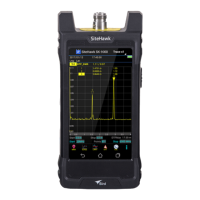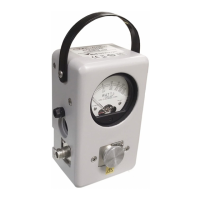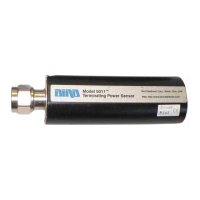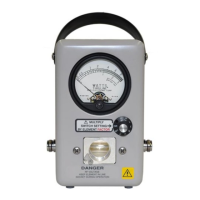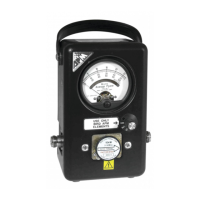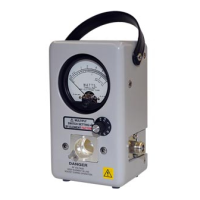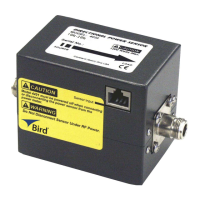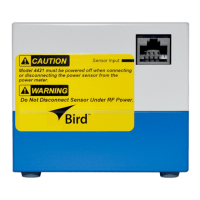Do you have a question about the BIRD SiteHawk SK-4500 and is the answer not in the manual?
Warning about live electrical circuits.
Warning about the risk of electric shock.
Caution against servicing equipment solo.
Importance of proper electrical grounding.
Need for familiarity with resuscitation methods.
Instruction to remove power before servicing.
Explanation of warning and caution symbols.
List of important equipment cautions.
General caution regarding instrument usage.
Safety instructions for service personnel.
Safety notes for battery handling.
Information on manual updates and revisions.
Overview of manual's chapter structure.
General description of the SiteHawk Analyzer.
Information on using the RF Meter App.
List of accessories included with the unit.
List of available optional accessories.
Key technical specifications of the device.
Specifications for the calibration unit.
Specifications for the 1-meter RF cable.
Features and functions of the analyzer.
Description of the unit's connectors and ports.
Details on battery, powering on/off, and sleep mode.
Description of the 50 ohm N-type measurement port.
General overview of the touch screen interface.
Specific UI elements for match mode.
UI elements for various measurement modes.
Procedure to set frequency parameters.
Procedure to select data points.
Configuring distance units and cable values.
Procedures for setting cable loss.
Editing and using the cable list.
Adjusting trace display parameters.
Manually adjusting the trace scale.
Step-by-step guide for device calibration.
Choosing measurement modes and units.
Defining the frequency range for measurements.
Understanding the match measurement graph.
Important notes for cable loss testing.
Step-by-step procedure for cable loss.
Understanding the cable loss measurement graph.
Introduction to impedance discontinuities.
Factors affecting fault location range.
Impact of data points on measurement distance.
Relationship between span and measurable distance.
Importance of Vp for accurate measurements.
Formula and example for frequency span calculation.
Choosing between DTF_SWR and DTF_RL.
Understanding the fault location graph.
Table of common return loss values.
Notes for interpreting fault location results.
Setting and using limit lines for trace analysis.
Adjusting limit line position and step size.
Enabling pass/fail indicators and alarms.
Overview of marker usage.
Steps to add, move, and search markers.
How to use delta markers for comparisons.
Using markers to find peak signals.
Accessing MEM, FREQ, RESET, FILE, PNG, SYS menus.
Procedures for file management.
Methods for saving and recalling trace data.
Capturing and saving screen images.
Procedure for deleting stored files.
Setting a name for screenshots.
Using RESET and PNG icons.
Customizing display and viewing device info.
Instructions for cleaning the analyzer.
Steps for replacing the internal battery.
Recommended calibration intervals.
Recommended storage conditions.
Adding new cables to the list.
Deleting, saving, and recalling cable lists.
Editing cable list using PC software.
Saving and recalling instrument settings.
Description of CSV and S1p file formats.
Procedures for saving various file types.
Loading previously saved trace data.
Procedure for deleting files from storage.
Overview of data transfer methods.
Steps for transferring data via USB.
Steps for transferring data via Bluetooth.
Making storage options visible in settings.
Steps to update the device firmware.
Contact details for technical support.
List of default settings for the analyzer.
Details of the product's limited warranty.
Warning about live electrical circuits.
Warning about the risk of electric shock.
Caution against servicing equipment solo.
Importance of proper electrical grounding.
Need for familiarity with resuscitation methods.
Instruction to remove power before servicing.
Explanation of warning and caution symbols.
List of important equipment cautions.
General caution regarding instrument usage.
Safety instructions for service personnel.
Safety notes for battery handling.
Information on manual updates and revisions.
Overview of manual's chapter structure.
General description of the SiteHawk Analyzer.
Information on using the RF Meter App.
List of accessories included with the unit.
List of available optional accessories.
Key technical specifications of the device.
Specifications for the calibration unit.
Specifications for the 1-meter RF cable.
Features and functions of the analyzer.
Description of the unit's connectors and ports.
Details on battery, powering on/off, and sleep mode.
Description of the 50 ohm N-type measurement port.
General overview of the touch screen interface.
Specific UI elements for match mode.
UI elements for various measurement modes.
Procedure to set frequency parameters.
Procedure to select data points.
Configuring distance units and cable values.
Procedures for setting cable loss.
Editing and using the cable list.
Adjusting trace display parameters.
Manually adjusting the trace scale.
Step-by-step guide for device calibration.
Choosing measurement modes and units.
Defining the frequency range for measurements.
Understanding the match measurement graph.
Important notes for cable loss testing.
Step-by-step procedure for cable loss.
Understanding the cable loss measurement graph.
Introduction to impedance discontinuities.
Factors affecting fault location range.
Impact of data points on measurement distance.
Relationship between span and measurable distance.
Importance of Vp for accurate measurements.
Formula and example for frequency span calculation.
Choosing between DTF_SWR and DTF_RL.
Understanding the fault location graph.
Table of common return loss values.
Notes for interpreting fault location results.
Setting and using limit lines for trace analysis.
Adjusting limit line position and step size.
Enabling pass/fail indicators and alarms.
Overview of marker usage.
Steps to add, move, and search markers.
How to use delta markers for comparisons.
Using markers to find peak signals.
Accessing MEM, FREQ, RESET, FILE, PNG, SYS menus.
Procedures for file management.
Methods for saving and recalling trace data.
Capturing and saving screen images.
Procedure for deleting stored files.
Setting a name for screenshots.
Using RESET and PNG icons.
Customizing display and viewing device info.
Instructions for cleaning the analyzer.
Steps for replacing the internal battery.
Recommended calibration intervals.
Recommended storage conditions.
Adding new cables to the list.
Deleting, saving, and recalling cable lists.
Editing cable list using PC software.
Saving and recalling instrument settings.
Description of CSV and S1p file formats.
Procedures for saving various file types.
Loading previously saved trace data.
Procedure for deleting files from storage.
Overview of data transfer methods.
Steps for transferring data via USB.
Steps for transferring data via Bluetooth.
Making storage options visible in settings.
Steps to update the device firmware.
Contact details for technical support.
List of default settings for the analyzer.
Details of the product's limited warranty.
| Impedance | 50 Ohm |
|---|---|
| Return Loss | 0 to 60 dB |
| Cable Loss | 0 to 30 dB |
| Battery | Rechargeable Li-Ion |
| Accuracy | ±0.5 dB |
| Operating Temperature | -10°C to +50°C |
| VSWR | 1.00 to 65.0 |
| GPS | Yes |
| Data Storage | Internal memory, USB |
| Interface | USB |
